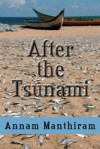After the Tsunami
Annam Manthiram’s first novel, After the Tsunami, a finalist in the 2010 Stephen F. Austin State University Press Fiction Contest, is a powerful story of endurance but also a disturbing picture of an orphanage for boys in India. The inspirations for this novel were first, the experiences of the author’s two elder sisters in a boarding school and secondly, the 2004 Indian Ocean tsunami. In this novel, the boys had either lost their parents in the tsunami or were abandoned by living parents. Since the orphanage’s “Mothers” were so arbitrarily brutal, the boys had to bond to survive, but their shifting alliances also had consequences. Siddhartha, the narrator, a successful teacher in the U.S. with a loving family, is haunted by what happened to his friends and what he did himself to add to the brutality in the “House.”
Annam Manthiram’s first novel, After the Tsunami, a finalist in the 2010 Stephen F. Austin State University Press Fiction Contest, is a powerful story of endurance but also a disturbing picture of an orphanage for boys in India. The inspirations for this novel were first, the experiences of the author’s two elder sisters in a boarding school and secondly, the 2004 Indian Ocean tsunami. In this novel, the boys had either lost their parents in the tsunami or were abandoned by living parents. Since the orphanage’s “Mothers” were so arbitrarily brutal, the boys had to bond to survive, but their shifting alliances also had consequences. Siddhartha, the narrator, a successful teacher in the U.S. with a loving family, is haunted by what happened to his friends and what he did himself to add to the brutality in the “House.”
The friends are each distinct, and the events and characters evolve slowly and believably to escalating brutality. At first the House does not seem so bad to the boys. Caste distinctions fall away:
Most of us forgot who we were. It was as if the sea, for those of us who had come from the sea, had recreated our existence, and we were free to become whoever we wanted to be. The only time our social class was most evident was when the mothers reinforced our backgrounds—almost colonial-like, and their efforts to pit us against each other worked to serve as some sort of self-inflicted discipline, which they did not have to endure.. . . we tried to keep the hope of [our parents] returning alive by talking about what we would do if they were to return.
This possibility of the parents coming to take the boys away plays a sad crucial part at the end.
Among the “friends” is the bully Jaga-Nai, who takes from other boys and attacks them viciously, always without being punished. Golicchio pictures his father coming in a rainbow, because this boy is an extravagant storyteller. As he says of himself, “I always saw things as I thought they should be.” Peepa means “barrel,” because he can never quench his thirst. He’s also the most handsome boy. The biggest boy, Ganesh, in spite of his muscles, gets away with doing little work, because he’s of the upper caste. Puni has eyes that never blink and is always hungry. Along with the boys, a mysterious, lovely girl appears in the greenhouse, supposedly watering the plants, only her pitcher holds no water.
Siddartha, as an adult, mentions that he cannot eat fish and is glad that the place he lives in is foggy so that he does not see the stars. The reader eventually finds out why. We also find out why Jaga-Nai is a bully and why Headmistress Veli is nice. Among the “Mothers,” young Sid thinks she is the kindest since she sometimes gives sweets and extra food to him. The boys are always hungry, given inadequate and rotten food, while the Mothers are fat. The government allots new clothes for each boy every year, but most of the pants and shirts are stained or torn except those for Ganesh and Jaga-Nai. Boys are put in the Closet, a dirty, dark place where they cannot stand upright, for a night or longer or even forgotten in there. The boys retaliate to some degree by snooping and enjoying what they find in the Mothers’ rooms when they are absent.
The author is skillful in merging past with present throughout. Most of Siddartha’s before-tsunami memories have to do with his sister Smita, whom his father loved more than him. When Golicchio and Peepa become close and started to
sound the same, envy boiled inside of me like payasum on a hot stove. I felt as though I were in the middle, intruding on a special moment, not unlike the times I’d tried talking to my father when he was playing with Smita.
The end reveals horrors in what happens to some of the boys and in the actions of the Mothers. Siddartha feels guilt for what he does, as well as what he doesn’t prevent. The reader understands how the boys change incrementally in this short saga. Siddartha has to recognize he has become a mini Jaga-Nai the bully, and yet he does fight against the Mothers’ corruption. He is a strong survivor for being forced to face his past at the end.
The only slight criticism of this book might be that each long chapter consists always of mostly dialogue and, blended past and present, Siddartha’s thoughts. Also, no place names or dates are given. However, you care about the characters, and this page-turner will stay with you.





